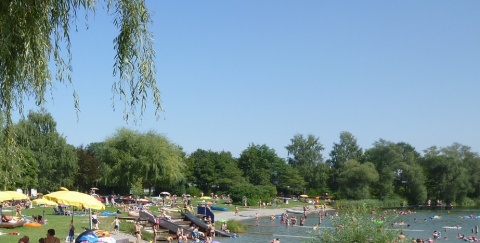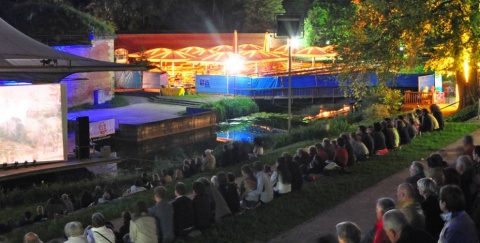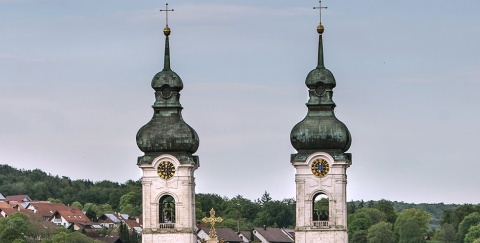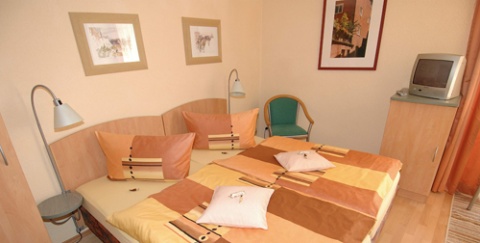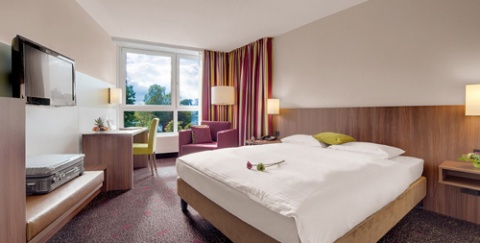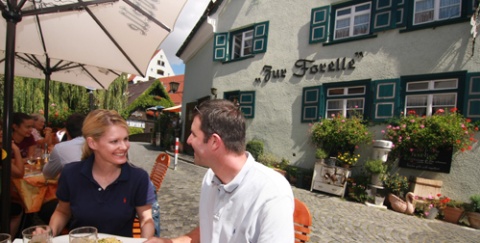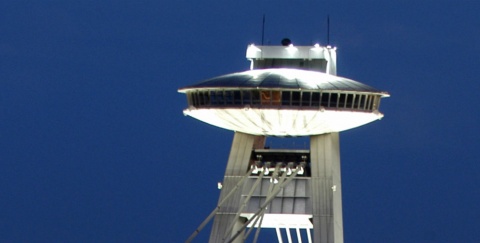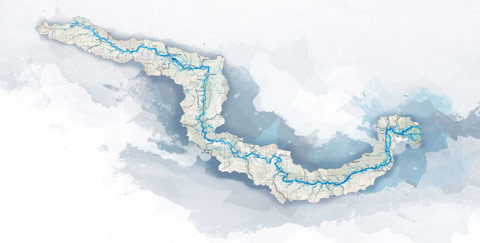

Blaubeuren
It would be something of an exaggeration to call the river Blau, which originates in Blaubeuren, an important river. After just 15 kilometres, it flows into the Danube. What is significant, however, is the source of the Blau, the Blautopf ('blue pot'), which provides profound insights into the histo...
Country: Germany
Blaubeuren is a town in the Alb-Danube district of eastern Baden-Württemberg and has a population of approximately 12,000 people. The town centre lies at the foot of the Swabian Alb, 16 kilometres west of Ulm. Blaubeuren is located on the main Upper Swabian Baroque Route and on the southern stretch of the German Half-Timbered Houses Route.
The Blautopf is one of Germany's largest springs in terms of water output. On average 2,000 litres gush from the depths of the Earth every second – and up to 32,000 litres after torrential rain. It has a funnel-like shape which is 21 metres at its deepest point, and is 40 metres in diameter.
City Highlights
The caves on the southern edge of the Swabian Alb are among the most important Palaeolithic sites in the world. The cultural roots of Europe's Upper Palaeolithic Age lie in the valleys of the rivers Ach, Blau and Lone. Some 40,000 years ago, early Europeans developed new types of tool here and created figurines of people and animals from mammoth ivory. Those that have been found are among the oldest known examples of art and many are on display at the Museum of Prehistory. The museum unites scientific research, experimental archaeology and a modern education concept under one roof. Here you will find the earliest examples of human figurative art displayed alongside works from the 20th century. The highlights of the collection are the Venus of Hohle Fels and a flute made of a swan bone, the oldest musical instrument ever to have been discovered. The Museum of Prehistory also paints a vivid picture of how Neanderthals and early modern humans lived during the last Ice Age and what happened when they encountered each other 40,000 years ago.
There are indications that a bath house was built at the abbey out of concern for the moral integrity of the monks, who up to that point had visited the public baths in Blaubeuren with their worldly pleasures and temptations. The monastic bath house at Blaubeuren Abbey is the only one that has survived in Germany. Today you can still see the area where the hot water was prepared and transferred into large wooden tubs using buckets. The rooms of the bath house are of great cultural and historical significance and now accommodate Blaubeuren's local history museum. The exhibition, which is as fascinating as it is varied, documents the history of Blaubeuren, the abbey and the Reformation.
The Blautopf is an enigmatic and mystical place, and is all the more magical because of the deep blue colour of the water. It is so intense that people once thought it was coloured with ink. The Blautopf is only a small part of a labyrinthine cave system, which remains largely unexplored today, whose actual size is a matter of speculation. What is known, however, is that humans settled here some 40,000 years ago – a fact that is confirmed by numerous finds displayed at the Blaubeuren Museum of Prehistory. These include the Venus of Hohle Fels, the oldest example of human figurative art ever discovered. There is no denying that Blaubeuren, with its picturesque town centre and abbey, is still a desirable place to live today. On a stroll through the late-medieval Gerberviertel (tanners' quarter), you'll discover delights at every turn. Criss-crossed by narrow channels of water and blessed with idyllic lanes and romantic corners, this part of town is known as Little Venice. Visitors to Blaubeuren can also enjoy trips in the scenic countryside of the Swabian Alb, the warm hospitality of the local people and a good dose of Swabian gemütlichkeit. It is no wonder our ancestors decided to settle here tens of thousands of years ago.
Blaubeuren's former abbey, founded in 1085, is located right by the Blautopf. The abbey was originally going to be built on the higher ground of the Alb, but its founders settled for the site near the spring, probably because of the guaranteed water supply there. In the 14th and 15th centuries, the Benedictine abbey went into decline, was abandoned and rapidly fell into disrepair. However, three abbots laid the groundwork for the rebuilding and restoration of the abbey in the late-Gothic style – and that is largely how the building appears today. The high altar and choir stalls are magnificent testimonies to the creativity of the medieval craftsmen. Both were created in around 1493 by sculptors and painters from the Ulm School and are works of European standing.
Opening times:
Summer season (1 March to 1 November)
Daily: 10am-6pm
Winter season (2 November to 28 February)
Monday to Friday: 2pm-4pm
Saturday, Sunday and public holidays: 11am-4pm
Closed on 24, 25 and 31 December and 1 January.
Accommodation, restaurants and cuisine
Blaubeuren is a popular tourist destination that offers a wide range of accommodation and restaurants. You'll find everything here from four-star hotels to cosy inns, plus a wide selection of self-catering apartments, youth hostels, campsites, B&Bs and private accommodation. The many restaurants cater for every taste as well, with choices ranging from hearty traditional fare to gourmet and international cuisine.
Activities in Blaubeuren
The Swabian Alb is the no. 1 climbing area in Baden-Württemberg, with around 150 crags that are suitable for climbing. Three rock formations on the northern fringes of Blaubeuren (Glasfels, Breitfels and Blaufels), offer a wide choice of routes for climbers of all abilities. The limestone rocks offer slab climbing, crack climbing, overhangs and chimneys, mainly on well-secured routes and graded between 2 and 10 for difficulty. The Aach valley near Weiler has many striking geological features including the rock labyrinth, the rocky plateau of the former Günzelburg Castle and Geissenklösterle cave. On the southern edge of Blaubeuren, seasoned climbers can have a go at two of the most spectacular roof climbs in Germany, the Grosse Grotte (large grotto) and Blautalwand (Blau valley wall). Blau valley is one of the few climbing areas with crags right in the centre of town, perfect for people travelling by train.
The Christian Schmidbleicher outdoor pool is particularly family friendly. It has a 65m waterslide, a shallow pool, a 3m diving platform, a mushroom fountain, water jets and massage jets, large sunbathing lawns and a great children's pool with a sandy play area. The highlight of the season is the pool's annual summer festival with its spectacular firework display. A little further down from the outdoor pool is a large indoor pool complex with a teaching pool, sauna suite and an attractive cafeteria.
The traditional Swabian railway has a nostalgic offshoot in Blaubeuren: the Blautopfbähnle, a train on wheels that takes visitors to places of interest and picturesque vantage points in and around the town. On weekends from April to October, the panoramic tour passes through the prettiest lanes of the medieval town centre and follows scenic routes to beauty spots and look-out points. Individuals, families and small groups can climb aboard at the departure point at the Blautopf. In addition to the panoramic tour, other themed tours for groups include the caves tour, Schillerstein tour and nature tour.
In Sonderbuch, there is an airfield for single-engine aircraft up to 2 tonnes, helicopters up to 3 tonnes and gliders. There are no fixed opening hours, but it is nearly always open at weekends. Blaubeuren Flying Club offers beverages, coffees and cakes at its clubhouse. There is also a barbecue area on site. It is possible to book sightseeing flights in a glider or a plane at cost price.
The Alb plateau around Seissen offers up to twelve kilometres of prepared cross-country skiing trails and around six kilometres of prepared skating trails. There is parking with direct access to the trails at the Mehrzweckhalle (multi-purpose hall) and Wanderparkplatz Linde (Linde walkers' car park). These trails can only be used in daylight hours to avoid disturbing the wildlife. There is, however, a floodlit ski lift and skiing area in Beiningen.
Contact:
Blaubeuren Tourist Information
Kirchplatz 10
89143 Blaubeuren
Tel.: +49 (0)7344 966 990
tourist@blaubeuren.de
www.blaubeuren.de
Opening times:
15 March to 30 November:
Tuesday to Sunday 10am-5pm
1 December to 14 March:
Tuesday to Saturday 10am-12 noon,
Tuesday and Saturday 2pm-5pm,
Sunday 10am-5pm
DANUBE.TRAVEL has no control over the website content generated by users and/or visitors, neither such content represents a statement, opinion, recommendation or rating by DANUBE.TRAVEL. For further information please refer to DANUBE.TRAVEL – General Website Terms and Conditions of Use.
 EN
EN DE
DE
